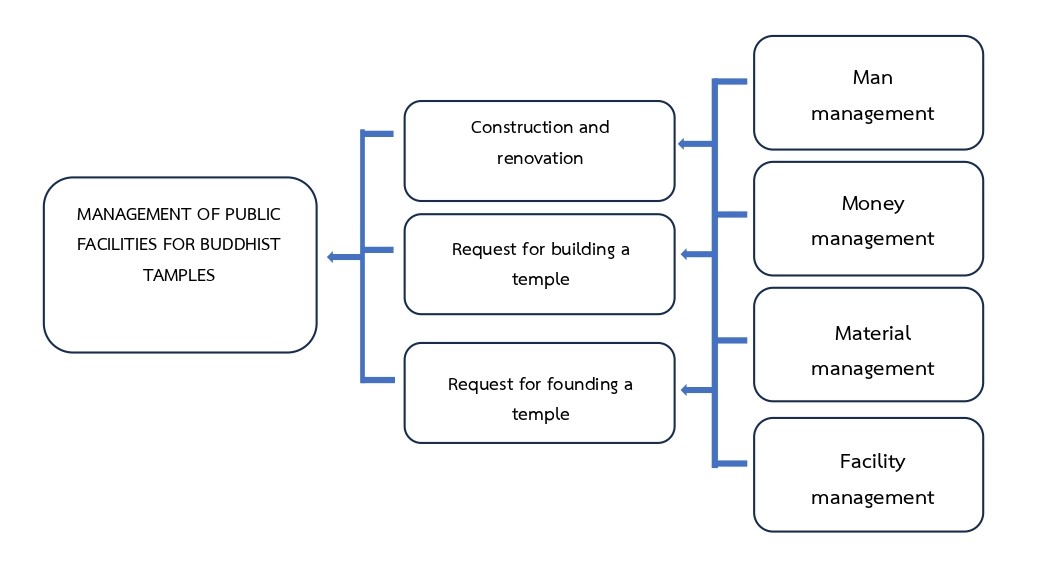MANAGEMENT OF PUBLIC FACILITIES FOR BUDDHIST TEMPLES IN BAN NA SAN DISTRICT, SURAT THANI PROVINCE
Keywords:
Management, Public infrastructure, Group of Buddhist monks, Ban Na San, Surat ThaniAbstract
Background and Objectives: Buddhism involves the way of life, culture, customs, traditions, and socialization. Therefore, an abbot must take action for the public facility concerns, which is one of the six works. The management of public facilities consists of construction and renovation for any kind of temple facilities. Likewise, they are concerned with the request for the royal grant of the temple area and related to the conduct of founding and building a temple. Building permanent public facilities yields significance to the faith of Buddhism among Buddhists. For this research, the objectives are; To study general condition in the management of public facilities for Buddhist temples in administrative area of the Sangha in Ban Na San district, Surat Thani province and study the problems, obstacles, and guidelines for the management of public facilities to find pattern or guideline for solution of possible problems in the management of public facilities for Buddhist temples in Ban Na San district, Surat Thani province.
Methodology: This mixed-methods research, in which data were collected by literature review and in-depth interviews with key informants from three sub-districts, which included Na San sub-district, Khuan Suban sub-district, and Phru Phi sub-district. All three sub-districts had 195 Buddhist monks and novices for in-depth interviews. The qualitative data were gathered from five key informants who were ecclesiastical official monks, which included the Ecclesiastical District Officer of Ban Na San district, the Ecclesiastical Commune-Chief of Khuan Suban sub-district, the Ecclesiastical Commune-Chief of Na San sub-district, the abbot of Khuan Suban Temple, and the abbot of Khuan Si Temple.
Main Results: The results of this research indicated: 1) The demographic of the key informants in “Management of Public Facilities for Buddhist Temples in Ban Na San district, Surat Thani Province” consisted of the following details: Most respondents were Buddhist monks in the temples between 31-40 age, 11-20 years of ordination and obtained the Dhamma scholar advanced level in education; 2) The Buddhist monks and novices, who had opinions on management, had the highest level of mean value. In the secondary, it was facility management, then the money management. Materials management had the lowest mean value. All aspects had been respectively sorted; 3) The study of the process comprised 3.1) To support Buddhist monks and personnel in the temples to be well educated in public facility technology and to use this technology for designing the construction and doing the public announcement, 3.2) should have planned the budget for renovation in a worthwhile and economical manner, 3.3) Purchasing materials, equipment of appliances within the temple should take into account the principle of value for money, that is, useful and extremely economical, and 3.4) to manage with appropriate and systematic approaches by planning, implementing, controlling, follow-up and assessment.
Involvement to Buddhadhamma: The temple development integrates the concept of Brahmavihāra with modern theories. It is related to Applied Buddhism with regard to Buddhism and sustainable development. There are loving-kindness or benevolence (Mettā), compassion (Karunā), empathetic joy (Muditā), equanimity (Upekkhā) or being free from attachment to everything and considering with intelligence in the management of temple public facilities.
Conclusions: Managing public facilities was a mission of temples and Buddhist monks toward the development of buildings and the environment, such as the renovation of both the Buddhāvāsa area and Saṅghāvāsa area, or the mission of the construction and reparation. The maintenance of buildings and public facilities included the construction of the Uposatha hall, classroom building, preaching hall, monastery library, dormitory, crematorium, and temple property accounting management.
References
Phrakhrusangharak Anan Sutdhimano, Phramaha Krisada Kittisobhano, & Phrapalad Raphin Buddhisaro. (2021). A model of Buddhist construction management according to monastery, people and state for happiness creation project of Sangha administration, pathumthani province. Journal of MCU Social Science Review, 10(1), 171-182.
Phra Rector Somchai Somchato. (2011). The role of the Sangha Commander in the management of the religious treasures of the temple in Bang Phae District. Ratchaburi Province [Unpublished master's thesis]. Mahachulalongkornrajavidyalaya University.
Phrasamu Charoen Kwesco. (2011). Management of the religious treasures of the Sangha Commission in Samut Songkhram province [Unpublished master's thesis]. Mahachulalongkornrajavidyalaya University.
Phrasamu Ek Chinwamso. (2012). Public Participation on Temple Facilities Establishing: A Case Study of Phraintharacha Municipality, Bang Pa-In District, Phranakhon Si Ayutthaya Province [Unpublished master's thesis]. Mahachulalongkornrajavidyalaya University.
Phramaha Sirichai Sirinathaya. (2014). Strategic human resource management Of the Subdistrict Administration Organization In Lam Plai Mat District Buriram Province [Unpublished master's thesis]. Mahachulalongkornrajavidyalaya University.
Phramaha Somchai Santikaro. (2013). Participation of the people in building public utilities: Case study in Phra Inracha Sub -district Municipality, Bang Pa -In District Phra Nakhon Si Ayutthaya Province [Unpublished master's thesis]. Mahachulalongkornrajavidyalaya University.
Phramaha Thachathorn Sirimongklo. (2014). Buddhist tourism management of Nong Waeng Temple, Phra Aram Luang, Mueang District, Khon Kaen Province [Unpublished master's thesis]. Mahachulalongkornrajavidyalaya University.
Phramaha Thawin Piyathommo. (2013). Study of the work and the propagation of Buddhism with work. The public image of Phra Kru Sophon Bunsarathasophon [Unpublished master's thesis]. Mahachulalongkornrajavidyalaya University.
Phramaha Thirasuk Thammasaro. (2013). Educational Management of Phra Pariyatham, Pali Department: Case Study Moli Lokyaram Temple Bangkok Yai District Bangkok [Unpublished master's thesis]. Mahachulalongkornrajavidyalaya University.
Phramaha Wirarat Mahaweero. (2011). The religious management of the temple of the Sangha Commission in Samut Songkhram Province [Unpublished master's thesis]. Mahachulalongkornrajavidyalaya University.

Downloads
Published
How to Cite
Issue
Section
License
Copyright (c) 2023 Journal of Buddhist Anthropology

This work is licensed under a Creative Commons Attribution-NonCommercial-NoDerivatives 4.0 International License.







